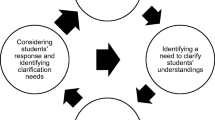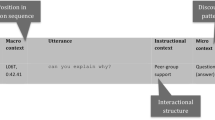Abstract
Science communication competence (SCC) is an important educational goal in the school science curricula of several countries. However, there is a lack of research about the structure and the assessment of SCC. This paper specifies the theoretical framework of SCC by a competence model. We developed a qualitative assessment method for SCC that is based on an expert–novice dialog: an older student (explainer, expert) explains a physics phenomenon to a younger peer (addressee, novice) in a controlled test setting. The explanations are video-recorded and analysed by qualitative content analysis. The method was applied in a study with 46 secondary school students as explainers. Our aims were (a) to evaluate whether our model covers the relevant features of SCC, (b) to validate the assessment method and (c) to find characteristics of addressee-adequate explanations. A performance index was calculated to quantify the explainers’ levels of competence on an ordinal scale. We present qualitative and quantitative evidence that the index is adequate for assessment purposes. It correlates with results from a written SCC test and a perspective taking test (convergent validity). Addressee-adequate explanations can be characterized by use of graphical representations and deliberate switches between scientific and everyday language.








Similar content being viewed by others
References
ACARA (2012). The Australian Curriculum—Science. Australian Curriculum, Assessment and Reporting Authority.
Aikenhead, G. S. (2001). Science communication: A cross cultural event. In S. M. Stocklmayer, M. G. Gore, & C. Bryant (Eds.), Science communication in theory and practice (pp. 23–46). Dordrecht: Kluwer Academic.
Berland, L. K., & McNeill, K. L. (2012). For whom is argument and explanation a necessary distinction? A response to osborne and patterson. Science Education, 96(5), 808–813.
Bernholt, S., Eggert, S., & Kulgemeyer, C. (2012). Capturing the diversity of students’ competences in science classrooms: Differences and commonalities of three complementary approaches. In S. Bernholt, K. Neumann, & P. Nentwig (Eds.), Making it tangible: learning outcomes in science education (pp. 173–201). Münster: Waxmann.
Bortz, J., & Döring, N. (2006). Forschungsmethoden und Evaluation für Human- und Sozialwissenschaftler. Heidelberg: Springer Medizin.
Braaten, M., & Windschitl, M. (2011). Working toward a stronger conceptualization of scientific explanation for science education. Science Education, 95(4), 639–669.
Bricker, L. A., & Bell, P. (2008). Conceptualizations of argumentation from learning science studies and the learning sciences and their implications for the practices of science education. Science Education, 92, 437–498.
Brown, G. (2006). Explaining. In O. Hargie (Ed.), The handbook of communication skills (pp. 195–228). East Sussex: Taylor & Francis.
Bucchi, M., & Trench, B. (Eds.). (2008). Handbook of public communication of science and technology. Abingdon: Routledge.
Campbell, D., & Fiske, D. (1959). Convergent and discriminant validation by the multitrait multimethod matrix. Psychological Bulletin, 56(2), 81–105.
Chandrasegaran, A. L., Treagust, D. F., & Mocerino, M. (2008). An evaluation to promote students’ ability to use multiple representation when describing and explaining chemical reactions. Research in Science Education, 38, 237–248.
Clark, H. (1996). Using language. Cambridge: Cambridge University Press.
CSMEE (Center for Science, Mathematics, and Engineering Education). (1996). National science education standards. Washington: National Academy Press.
Davis, M. (1980). A multidimensional approach to individual differences in empathy. Catalogue of Selected Documents in Psychology, 10MS. 2124, 85.
Driver, R., Newton, P., & Osborne, J. (2000). Establishing the norms of scientific argumentation in classroom. Science Education, 84(3), 287–312.
Edmondston, J., Dawson, V., & Schibeci, R. (2010). Undergraduate biotechnology students’ views of science education. International Journal of Science Education, 32(18), 2451–2474.
Einhaus, E. (2007). Schülerkompetenzen im Bereich Wärmelehre. Berlin: Logos.
Einhaus, E. & Schecker, H. (2007). Modelling science competencies. Proceedings of the Sixth International ESERA Conference (CD).
Gage, N. (1968). The microcriterion of effectiveness in explaining. In N. Gage (Ed.), Explorations of the teacher’s effectiveness in explaining, Technical Report No. 4 (pp. 1–8). Stanford Center for Research and Developement in Teaching.
Gilbert, J. (2006). On the nature of “context” in chemical education. International Journal of Science Education, 28(9), 957–976.
Gilbert, J. & Treagust, D. F. (2009). Macro, submicro and symbolic representations and the relationship between them: Key models in chemical education. In J. Gilbert & D. Treagust (Ed.), Multiple representations in chemical education. New York: Springer.
Hafner, R. (2007). Standards in science education in Australia. In D. Waddington, P. Nentwig, & S. Schanze (Eds.), Making it comparable. Standards in science education (pp. 23–60). Münster: Waxmann.
Kauertz, A. (2008). Schwierigkeitserzeugende Merkmale physikalischer Leistungstestaufgaben. Berlin: Logos.
Kauertz, A., Fischer, H., Mayer, J., Sumfleth, E., & Walpuski, M. (2012). Standardbezogene Kompetenzmodellierung in den Naturwissenschaften der Sekundarstufe I. Zeitschrift für Didaktik der Naturwissenschaften, 16, 135–155.
King, A., Staffieri, A., & Adelgais, A. (1998). Mutual peer tutoring: effects of structuring tutorial interaction to scaffold peer learning. Journal of Educational Psychology, 90(1), 134–152.
Klieme, E., Avenarius, H., Blum, W., Döbrich, P., Gruber, H., Prenzel, M., et al. (2003). Zur Entwicklung nationaler Bildungsstandards—Expertise. Bundesministerium für Bildung und Forschung (BMBF).
KMK (Sekretariat der Ständigen Konferenz der Kultusminister der Länder in der Bundesrepublik Deutschland). (2005). Bildungsstandards im Fach Physik für den Mittleren Schulabschluss. München: Luchterhand.
Kremer, K., Fischer, H., Kauertz, A., Mayer, J., Sumfleth, E., & Walpuski, M. (2012). Assessment of standard-based learning outcomes in science education: Perspectives from the german project esnas. In S. Bernholt, K. Neumann, & P. Nentwig (Eds.), Making it tangible: learning outcomes in science education (pp. 201–218). Münster: Waxmann.
Kulgemeyer, C. (2010). Physikalische Kommunikationskompetenz. Modellierung und Diagnostik. Berlin: Logos.
Kulgemeyer, C. (2011). Physik erklären als Rollenspiel. Adressatengemäßes Kommunizieren fördern und diagnostizieren. Naturwissenschaften im Unterricht Physik, 22(123/124), 70–74.
Kulgemeyer, C., & Schecker, H. (2009). Physics communication competence: on the development of a domain-specific concept of communication. Zeitschrift für Didaktik der Naturwissenschaften, 15, 131–153.
Kulgemeyer, C., & Schecker, H. (2012). Physikalische Kommunikationskompetenz—Empirische Validierung eines normativen Modells. Zeitschrift für Didaktik der Naturwissenschaften, 18, 29–54.
Kunter, M., Schümer, G., Artelt, C., Baumert, J., Klieme, E., Neubrand, M., et al. (2002). PISA 2000—Dokumentation der Erhebungsinstrumente. MPI für Bildungsforschung.
Mayring, P. (2000). Qualitative content analysis. Forum: Qualitative Social Research [Online Journal], 1(2). Available at: http://www.qualitative-research.net/fqs-texte/2-00/2-00mayring-e.htm. Date of Access 21 Sep 2010.
MCEETYA (Ministerial Council on Education, Employment, Training and Youth Affairs) (2005). National assessment: Program, science, year 6, 2003: Technical report. MCEETYA.
McNeill, K. (2009). Teachers’ use of curriculum to support students in writing scientific arguments to explain phenomena. Science Education, 93(2), 233–268.
McNeill, K. (2011). Elementary students’ views of explanation, argumentation and evidence and abilities to construct arguments over the school year. Journal of Research in Science Teaching, 48(7), 793–823.
McNeill, K., & Krajcik, J. (2007). Inquiry and scientific explanations: Helping students use evidence and reasoning. In J. Luft, R. Bell, & J. Gess-Newsome (Eds.), Science as an inquiry in the secondary setting (pp. 121–134). USA: National Science Teachers Association.
Merten, K. (1995). Konstruktivismus als Theorie für die Kommunikationswissenschaft. MedienJournal, 4, 3–21.
Nagel, E. (1961). The structure of science: Problems in the logic of scientific explanation. London: Routledge and Kegan Paul.
Ogborn, J., Kress, G., Martins, I., & McGillicuddy, K. (1996). Explaining science in the classroom. Buckingham: Open University Press.
Osborne, J. F., & Patterson, A. (2011). Scientific argument and explanation: a necessary distinction? Science Education, 95(4), 627–638.
Osborne, J., Erduran, S., & Simon, S. (2004). Enhancing the quality of argumentation in school science. Journal of Research in Science Teaching, 41(10), 994–1020.
Rincke, K. (2011). It’s rather like learning a language: development of talk and conceptual understanding in mechanics lessons. Internationale Journal of Science Education, 33(2), 229–258.
Rusch, G. (1999). Eine Kommunikationstheorie für kognitive Systeme. In G. Rusch & S. Schmidt (Eds.), Konstruktivismus in der Medien- und Kommunikationswissenschaft (pp. 150–184). Frankfurt a. M.: Suhrkamp.
Schecker, H. (2012). Standards, competencies and outcomes. A critical view. In S. Bernholt, K. Neumann, & P. Nentwig (Eds.), Making it tangible: learning outcomes in science education (pp. 219–234). Münster: Waxmann.
Schecker, H., & Parchmann, I. (2006). Modellierung naturwissenschaftlicher Kompetenz. Zeitschrift für Didaktik der Naturwissenschaften, 12, 45–66.
Schecker, H., & Parchmann, I. (2007). Standards and competence models: The German situation. In D. Waddington, P. Nentwig, & S. Schanze (Eds.), Making it comparable. Standards in science education (pp. 147–164). Münster: Waxmann.
Schmidt, M. (2008). Kompetenzmodellierung und –diagnostik im Themengebiet Energie der Sekundarstufe I. Entwicklung und Erprobung eines Testinventars. Berlin: Logos.
Sevian, H., & Gonsalves, L. (2008). Analysing how scientists explain their research: a rubric for measuring the effectiveness of scientific explanations. International Journal of Science Education, 30(11), 1441–1467.
Shannon, C. (1948). A mathematical theory of communication. The Bell System Technical Journal, 27(379–423), 623–656.
Shulman, L. (1987). Knowledge and teaching: foundations of the new reform. Harvard Education Review, 57(1), 1–22.
Toulmin, S. (1958). The uses of argument. Cambridge: Cambridge University Press.
Treagust, D., & Harrison, A. (1999). The genesis of effective science explanations for the classroom. In J. Loughran (Ed.), Researching teaching: methodologies and practices for understanding pedagogy (pp. 28–43). Abingdon: Routledge.
Von Aufschnaiter, C., Erduran, S., Osborne, J., & Simon, S. (2008). Arguing to learn and learning to argue: case studies of how students’ argumentation relates to their scientific knowledge. Journal of Research in Science Teaching, 45(1), 101–131.
Weinert, F. (2001). Concept of competence—A conceptual clarification. In D. S. Rychen & L. H. Salyanik (Eds.), Defining and selecting key competencies (pp. 45–65). Göttingen: Hogrefe & Huber.
Wellenreuther, M. (2005). Lehren und Lernen - aber wie? Empirisch-experimentelle Forschung zum Lehren und Lernen im Unterricht. Hohengehren: Schneider.
Zeidler, D. L., Osborne, J., Erduran, S., Simon, S., & Monk, M. (2003). The role of argument during discourse about socioscientific issues. In D. L. Zeidler (Ed.), The role of moral reasoning on socioscientific issues and discourse in science education. Dordrecht: Kluwer Academic Publishers.
Acknowledgments
Parts of this paper were written during a stay of the first author at the Science and Mathematics Education Centre (SMEC), Curtin University of Technology, Perth, Australia. The authors gratefully acknowledge Prof David F. Treagust and Dr A. L. Chandrasegaran for all their supporting comments and advices. The authors address special thanks to Christine Rauch, M. Ed., for proofreading.
Author information
Authors and Affiliations
Corresponding author
Rights and permissions
About this article
Cite this article
Kulgemeyer, C., Schecker, H. Students Explaining Science—Assessment of Science Communication Competence. Res Sci Educ 43, 2235–2256 (2013). https://doi.org/10.1007/s11165-013-9354-1
Published:
Issue Date:
DOI: https://doi.org/10.1007/s11165-013-9354-1




